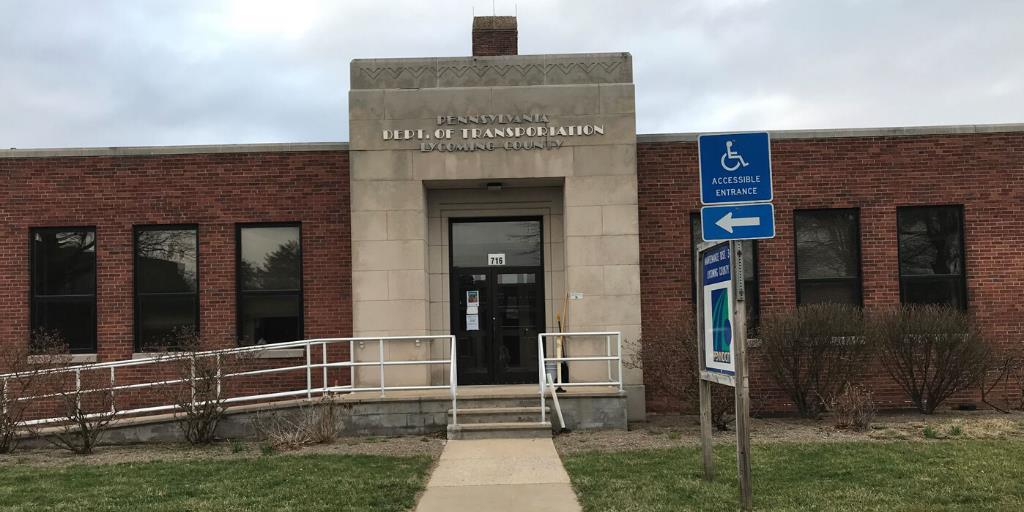
Did you know, the Public Works Administration (PWA), which operated during the Great Depression, built some of the buildings that the Pennsylvania Department of Transportation (PennDOT) still use to this day? In addition, the PWA built thousands of miles of highways across the United States, including part of the Pennsylvania Turnpike.
In 1937, the PennDOT facility at 716 Jordan Avenue in Montoursville, Lycoming County, was part of a large PWA project which included building 19 new garages and office buildings for what was then known as Department of Highways. The goal was to build satellite maintenance buildings in strategically located areas throughout the state to maximize efficiency throughout the Department's field force.
The project included the replacement of old sheet metal buildings with a new one or two-story fireproof structure with a brick exterior. The centrally-located buildings would provide the Department force with an updated service area to store the necessary equipment needed to maintain and construct the increasing demands of the growing highway system.
The overall cost of the Montoursville building was $124,323, with PWA providing $53,525.
The PennDOT Facility in Lewistown, located on West 4th Street, Mifflin County, was also built using PWA funding. The building was built in 1937, under the same project scope that the Montoursville PennDOT facility was built. This building cost $128,452, with PWA providing $54,425.
Not long after the PWA began building these maintenance buildings, the Pennsylvania Turnpike Commission began initiating plans to build a superhighway that would stretch across most of the Commonwealth.
During the Great Depression, the Commonwealth did not have the funds to support a project of this scale, so the Turnpike Commission turned to several funding sources within Franklin D. Roosevelt's New Deal to help fund the roadway. The Turnpike Commission pursued funding through the state's Works Progress Administration, PWA and the Reconstruction Finance Corporation, with agreements that tolls would repay any remaining debt.
Work on the superhighway began on October 27, 1938 and was required to be completed by June 1940. It took over "15,000 laborers working for 115 contractors and subcontractors from eighteen states" to complete the project.
An engineering marvel, that stretched 160 miles through rugged terrain, including seven tunnels and 300 structures, the Pennsylvania Turnpike became America's first superhighway and the first limited access superhighway in the nation.
On October 1, 1940, the Pennsylvania Turnpike officially opened becoming a success not only by providing thousands of jobs, but later, the Turnpike "served as a blueprint for the national interstate highway system" after President Dwight D. Eisenhower signed the Interstate Highway Act in 1956.
The PWA was established by the National Industrial Recovery Act on June 6, 1933 and spent over $6 billion on 34,000 projects between 1933 and 1939. The PWA was not a work relief program, but rather a program to help build America's infrastructure and stimulate private sector industry.
Many of these PWA projects are still used and maintained throughout the Commonwealth. District 3-0 in Lycoming County still utilizes the facility for their maintenance force office and the building in Lewistown is also still utilized by PennDOT.
Other notable PWA works include: the Hoover Dam (Nevada); the Triborough Bridge (New York); the Lincoln Tunnel (New York); and the Overseas Highway (Florida Keys).
ABOUT THIS BLOG
Did you know PennDOT is directly responsible for nearly 40,000 miles of highway and roughly 25,000 bridges? We oversee programs and policies affecting highways, urban and rural public transportation, airports, railroads, ports and waterways, in addition to administering the state's more than 11 million vehicle registrations and 8.8 million driver's licenses.
So, how do we do what we do? And how can we help you travel in Pennsylvania — whether it be for business or leisure — in safe and enjoyable manner? Read PennDOT Way to learn more about the department, what we do, and how and why we do it.
TAGS
50-Year Anniversary, 511PA, Aggressive Driving, Airports, Autonomous Vehicles, Bicycles, Bridges, Child Safety, Community Relations, Construction, COVID-19, Distracted Driving, District 1, District 10, District 11, District 12, District 2, District 3, District 4, District 5, District 6, District 8, District 9, DOTcom, Driver and Vehicle Services, Emergency Responders, Employment, Equity, FAQ Friday, Human Trafficking, Impaired Driving, Innovations, Live Free Ride Alive, Maintenance Monday, Motorcycles, Older Drivers, PA Motorcycle Safety Program, Pedestrians, PennDOT Connects, Ports, Public Transit, Railroads, REAL ID, Road MaP, Roadside Beautification, Rural Roads, Safety, School Buses, Seat Belts, State Transportation Innovation Council (STIC), Sustainability, Teen Drivers, Throwback Thursday, Transportation Funding, Travel in PA, Welcome Centers, Winter, Work Smart, Work Zone, Yellow Dot
LATEST POSTS
PennDOT Continues Sharing, Updating Resources for Local Governments to Pursue Bipartisan Infrastructure Law Funding Opportunities
Norwin High School Wins 2024 ‘Innovations Challenge’
Demo Complete: I-95 CAP Project in Center City Philadelphia
PennDOT Archeologist Connects Past, Present, and Future
Lehigh Valley DUI, Highway Safety Task Force Hosts Law Enforcement Seminar
ARCHIVES
2024
2023
2022
2021
2020
2019
2018
2017

